Oak Stix Experiment
This post documents the background and progress of an experiment I am conducting using Next Level Oak oak kits. In this experiment I am comparing the effects of American, French, and Hungarian oak stix vs. medium toast Hungarian oak cubes, each in 5 gallons of red wine.
Note: In this article I am referring to an entire kit (which is defined below) as “oak stix” for clarity, as “kit” has other meanings in home winemaking. If I’m referring to a specific part of a oak kit, I will name that part specifically.
Menu – jump to a section
Background
Oak Kits (oak stix)
The Experiment – updated 08/30/2021
Experiment Conclusions – updated 09/26/2021
updated 09/26/2021
Last Summer (2020) I read a post on WineMakingTalk regarding a new product from Next Level Oak. Mike (the owner) and I got into a private conversation regarding oak, wine making, business, and life in general. During our conversations I developed the idea for this experiment.
Note: as of August 2023, it appears that Next Level Oak is no longer in business.

Background
A quick background on use of oak in winemaking:
- white oak barrels became the norm for wine storage, due to many factors (tight grain, imparts pleasing flavor, availability, etc.)
- other woods can be used, with differing results; red oak is not used as the flavor it imparts has been described as “cat urine”
- wine stored in barrels absorbs flavoring (character) from the wood
- evaporation of water and alcohol occurs through the wood, which concentrates flavor and aroma
This section is a summary to provide background information for my experiment, written for all audiences, not just wine makers. It is not intended as a comprehensive primer on oak.
Although barrels can be used for decades for aging wine, the “oak character” imparted by a barrel has a very limited lifespan. By the time a barrel has been in use for 3 years, most of the oak character is consumed, although the evaporation still occurs so the barrel has value beyond its use as a container.
Oak character is an often desired trait; enough so that wine not fermented or aged in barrels may have oak adjuncts added for flavoring. Home winemakers often age red wines (and some whites) in glass carboys with oak adjuncts to add that flavor.
These products include oak chips, spirals, staves, and cubes. They are typically made of aged (1 to 3 years) white oak that has been toasted (baked) to various levels (light, medium, medium plus, and heavy). The different toast levels produce different flavor profiles. These adjuncts also have a limited lifespan, often 1 usage of 3 months duration. However, they are several orders of magnitude cheaper than barrels, so are generally considered worth the cost.
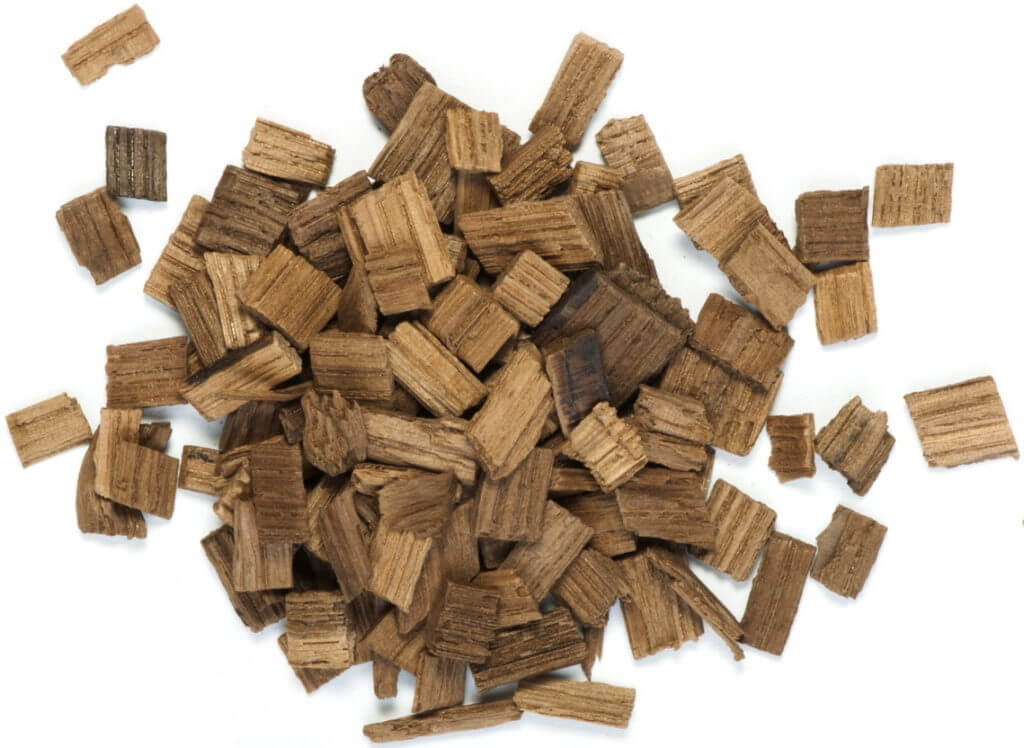
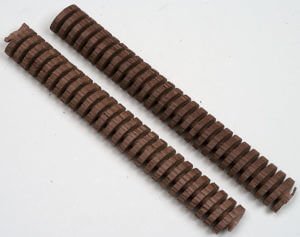
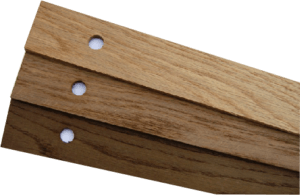
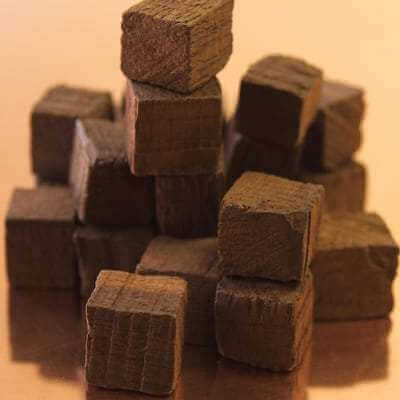
All these products work fine, each having its own advantages and disadvantages. Wine makers may choose to use any or all, based on personal preferences.
Spirals and staves can be dropped in a container, and some winemakers tie them with fishing line to suspend them in the wine, making retrieval much easier. However, each is a solid piece, so unless the winemaker is willing to cut or break them, the amount of oak added cannot be easily varied.
Chips and cubes are dropped into the wine, and the winemaker can use varying amounts according to personal choice. However, there’s no easy way to remove them without racking the wine. Also, the surface area that contacts the wine is variable depending on the sizes of the individual pieces. In this respect spirals and staves allow more consistent usage.

I have a pair of 54 liter (14.25 gallon) French oak barrels that are currently 11 years old. Barrels of this age are called “neutral” as they impart no oak character. I purchased these barrels specifically for this reason — depending on the size of the barrel, wine may be aged in a new barrel for as little as 6 weeks as the barrel will impart too much “character”. I wanted neutral barrels so I can age the wine for a year without over-oaking the wine.
Yet I want oak character, so I add adjuncts to the barrels to impart the oak character the barrels no longer can. My preference is cubes as these are relatively consistent in size and I can vary the amount easily. But removing them from a barrel or carboy can be a pain — turning an empty barrel over and shaking the cubes out is best done with 2 people.
Another point: In my own experience, I discovered that the wine near the cubes has a lot of oak character. This is not disbursed through the wine as there are no convection currents. Tasting the wine to determine if the oak adjunct has imparted the desired flavor and should be removed isn’t accurate unless the wine is gently stirred to spread the oak character. I learned this when I racked a barrel the first time — I poured the lees from the bottom of the barrel into a bottle to clear (a lot of wine can be recovered in this fashion). A week later I poured the cleared wine off the settled lees and tasted it. WOW! It was undrinkably over-oaked. However, when I used 1/5 gallon to top up a 14.25 gallon barrel, the oakiness diluted to good levels.
Oak Kits (oak stix)
Mike’s oak stix caught my attention, as it has the advantages of spirals and staves, but is more configurable. Each kit contains 4 pieces:
- drilled stopper – fits a carboy, having a cavity at the bottom that snugly holds the top piece in place; no need to use fishing line to suspend the product
- top piece – cylinder of white oak milled at the top to fit into the drilled stopper snugly enough that it won’t drop out, and has a dovetail (angled slot) at the bottom with which to attach to lower pieces
- bottom pieces — two cylinders of white oak, with dovetails on both ends, and slots cut through to increase surface area; these can be different toast levels, allowing mixing-n-matching
This fits a 5 or 6 US gallon carboy, and if only 1 bottom piece is used, fits 3 gallon carboys. At this time there are no bungs to fit barrels, but this is in development.
Altogether, the product is innovative.
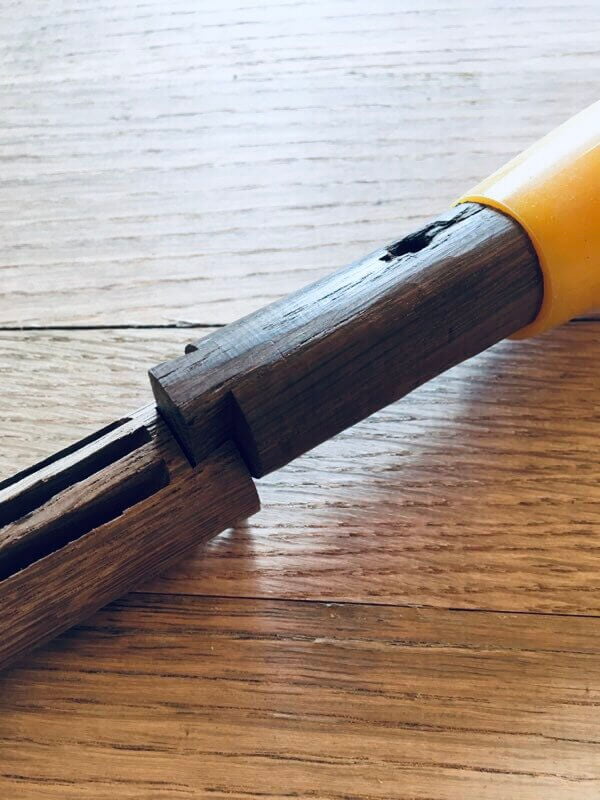
The one unknown with all oak adjuncts is “How much do I use?”
For oak cubes, I found very little guidance online, but after a lot of searching found a recommendation to use 2 oz cubes in 5 gallons wine for 3 months duration. I experimented with this and discovered it worked for me. This area is difficult, as different grapes take different levels of oak AND tastes in oak vary a lot so not everyone likes a heavily OR lightly oaked wine.
Guidance regarding spirals and staves is similarly scanty, but folks on WMT seemed to agree with 1 item for 5 gallons.
During my discussions with Mike, I calculated the surface area of both the oak stix and cubes. These calculations have a fair amount of error, as the surface are of the cubes is based on an average size, and the surface are of the slots of the oak stix is approximated.
However, I am satisfied that the surface area of a kit (2 segments + top piece) is just a bit less than 2 oz oak cubes. In my opinion, comparing oak stix to 2 oz cubes should be close enough to make a reasonable experiment.
The Experiment
Mike & I got into an extended discussion on this topic, and he agreed he needs facts on usage so he can advise his customers. This discussion led to this experiment.
Disclaimer: Next Level Oak provided 3 oak kits, one each of American, French, and Hungarian oak. Each kit has 1 lower piece of Medium toast and 1 of Medium Plus toast.
This is at no cost to me, and in return I am providing the results of my experiment for use by Next Level Oak. We are agreed that my test results will be provided “unvarnished”, e.g., my results are what they are, with all positive and negative points included.
Mike is confident that his product will work as expected, and honestly, so am I. While I’m keeping an open mind and recording my results objectively, based upon my experiences, the important result will be how much oak is imparted to 5 gallons of wine over a given time period. I do not foresee any issues arising that would not happen with any other oak adjunct.

Initial Test Conditions
- four 5 gallon carboys of 2nd run wine, made from the pomace from my 2020 west coast grapes; the grapes are 50% Merlot, 25% Zinfandel, and 25% Vinifera Blend (Cabernet Sauvignon, Cabernet Franc, Petit Verdot, & Malbec), varieties that are typically aged with oak.
- Next Level Oak kits in American, French, and Hungarian oak; each kit contains 1 piece Medium toast and 1 piece Medium Toast Plus.
- 2 oz medium toast Hungarian oak cubes.
The three kits each went into 1 carboy, and the 4th carboy received the cubes. I will be testing the wines every 2 weeks for oak character, recording my observations.
Note: A 2nd run wine is used for this experiment because it’s the only wine I have the 20 gallons necessary for the experiment.
Primary Goals
- Determine the duration required to impart a pleasing oak character to each wine
- Compare the results between the test samples to see how the oak stix compare to the cubes
- Determine if there is a different in the best duration for each of the oak stix types
Additional Goals
- Determine which sample(s) I like better, to help determine what type(s) of oak I’ll use in the future.
Summary as of 06/05/2021
- The differences in the 4 carboys appears to be more affected by the oak variety than the product.
Notes
| 02/27/2021 | Started the experiment. All wines are stable at SG 0.994 and are clear, e.g., 99% of the sediment has already dropped. However, it’s likely that the oak adjuncts will introduce oak particles, so I anticipate some sediment before this experiment is complete. |
| 03/21/2021 | Withdrew a sample of each wine, stirred the carboy gently (no air introduced), and added the sample back. Withdrew a tasting sample of each wine. The wines were tasted in the order listed, then tasted again in reverse order.
Oak Cubes — Has a subtle oak taste but little tannin registered on the tongue. American Stix — Oak taste is lesser than the cubes. Tannin registered on the sides of the tongue, starting near the tip and going back about 1/3 the length of the tongue. French Stix — Lesser oak taste. Tannin registered on the top of the tongue near the tip. Hungarian Stix — Oak taste similar to French stix. Tannin registered on the top of the tongue, farther back than the French. Wine tasted tart, which is odd as the wines 3 stix wines were homogenized prior to the test, so these 3 carboys are identical. In hindsight I question if I stirred the wines enough to homogenize each carboy. Next time I will withdraw a larger initial sample and gently use the powered stirring rod. |
| 04/17/2021 | A couple hours ahead, for each carboy I withdrew enough wine that I could use the powered stirring rod to mix the wine. Not enough to introduce air, but enough to ensure the carboy was homogenized. Then I replaced the sample.
During this process I compared samples of before and after stirring. With the Hungarian cubes, the difference was clear — the initial sample had a different taste the the stirred sample. For the stix? The difference was almost unnoticeable. Why are the cubes different? The cubes are at the bottom of the carboy and the sample came from the middle. For the stix the sample is taken from where the stix is, in the middle. The process of withdrawing the stix and then withdrawing enough wine to enable stirring appears to have mixed the wine. Oak Cubes — Detected astringency on the top of the tongue, but not much oak character yet. American Stix — Very little oak character and didn’t detect any astringency. French Stix — Detected astringency in the gums, not the tongue. Had a slightly sour taste with respect to the other wines. Hungarian Stix — Tasted a bit tart, but no more oak character than the other wines. This test was a bit of a surprise. I expected more oak character from all the wines, but there didn’t seem to be much more than last time. |
| 05/08/2021 | Again, I stirred the wines ahead of time to ensure they were homogeneous.
Oak Cubes — Strongest oak notes, developing well. American Stix — This sample was the fruitiest, which is not a surprise with American oak. Oak flavor was a bit less than the cubes. French Stix — Displayed the least oak flavor of the sample. Slight sour taste, which is common with French oak. Hungarian Stix — Good oak flavor developing. Still light but much improved from last tasting. This is roughly the 2.5 month mark. Overall, the oak character is developing nicely in all wines. I’m seeing the cubes developing a bit quicker, but my calculations indicated there was about 5% more surface area in the cubes, so it’s not a surprise. |
| 06/05/2021 | As previously, I stirred all 4 carboys ahead of time to homogenize the wines. We varied the tasting order to make things fresh — Hungarian, French, American, then the cubes.
Oak Cubes — Oak character is developing nicely, while being quite fruity. American Stix — Less oak character than the cubes, but developing nicely. Tannin noticeable on the top of the tongue. Less fruit than the French. French Stix — Less oak character than cubes or Hungarian, but again, developing nicely. Tannin noticeable on the gums, outside for me, inside the teeth for my son. Very fruit forward. Hungarian Stix — Best oak development of all samples, tannin noticeable on the top of the tongue. All wines are developing nicely, although differently. This should not be a surprise, as all oaks are different — it’s unlikely the Hungarian cubes and stix came from the same forest. The wines are obviously green, but my prediction is that the Hungarian stix will be #1 followed by the Hungarian cubes, French stix, and American stix. |
| 07/05/2021 | We used the same method — stir the wines ahead of time, then draw sample. This tasting was a disappointment and a good lesson. First the disappointment:
Hungarian Stix — Oak was muted, wine tasted a bit acidic. French Stix — Oak was muted, tasted flat. American Stix — Best oak and fruit of the oak stix wines, but still flat. Oak Cubes — Tasted best of the 4, but not as vibrant as last tasting. Now the lesson: Overall, all wines are disappointing at this time.
Looking back over the last 4 months since this experiment began, it’s clear the wines are all changing. Our results and preferred wine changed at each and every tasting. I know from experience that wine cycles, and a lot of my wines have undergone bottle shock, where a wine that was great at bottling time tastes like garbage 3 weeks later, and it back to good tasting 3 weeks after that. My thought is that we are experiencing something like that, a fluctuation in the wines that is at a down point on a sine curve. If it was just one carboy, I’d be worried about that carboy, and if the changes were identical between carboys I’d also be concerned. However, the differences reflect the differences we’ve experienced all along, so my educated guess is that this is simply a low point in the wine’s life cycle. We will taste again in 3 or 4 weeks and will know more at that time. |
| 08/30/2021 | For many reasons, the early August tasting did not happen. However, at this tasting, all wines were vastly improved from the last tasting.
Hungarian Stix — Oak character is present, but does not dominate the flavors. The wine is the most balanced it has been at any previous tasting. French Stix — Oak character is similar to the Hungarian stix, but is a bit sharper. American Stix — While similar to the other stix, the fruit is more forward. Oak Cubes — Oak flavor is a bit more prominent than with any of the stix. I can’t say better or worse; this is personal preference. This tasting is amazingly different from the last one, nearly 2 months ago. Last time, all the wines were disappointing. This time? All are more strongly flavored in general, but the oak is not a dominant flavor. It is a seasoning, not an ingredient. The results speak of aging, not about the individual oaks. Note: My son was not available, so the tasting notes are solely mine. |
| 09/26/2021 | Today my son & I conducted our final formal tasting, allowing for a full 7 months on the oak adjuncts.
Hungarian Stix — The oak character is a flavoring, not a dominant taste. The wine is well balanced. French Stix — Oak character is similar to the Hungarian stix, but is a bit sharper, maybe even acidic. The wine exhibits a bit of a sour taste, which some folks attribute to French oak. American Stix — As with the last tasting, this one is more fruit forward, although the oak is a bit stronger than the Hungarian. Overall, this one is also well balanced. Oak Cubes — While the oak character is a flavoring, this one is a bit stronger than the Hungarian stix. If tasted side-by-side it’s obvious, but if tasted at different times the flavoring might not be noted. Overall, we are pleased with all four wines, although our preferences differ a bit. In the final analysis, we like the Hungarian cubes best. Eric’s choice for second place is the American stix, while I prefer the Hungarian. Our choices for third place are reversed, Hungarian for Eric and American for me. The French stix is in fourth place. |
Experiment Conclusions
As of 09/26/2021, my son and I concluded our experiment with a final tasting, as our notes indicate.
The experiment started with 4 goals, 3 general and 1 personal:
Experiment Goals
- Determine the duration required to impart a pleasing oak character to each wine
- Compare the results between the test samples to see how the oak stix compare to the cubes
- Determine if there is a different in the best duration for each of the oak stix types
- Determine which sample(s) I like better, to help determine what type(s) of oak I’ll use in the future
The results are:
1. Determine the duration required to impart a pleasing oak character to each wine
This is a difficult one to judge, as folks have their own thresholds and likes in oak character. In re-reading our tasting results, it appears that most oak character was imparted by the end of the 4th month. Changes in the wine after that are the effects of bulk aging.
2. Compare the results between the test samples to see how the oak stix compare to the cubes
During the test, there were numerous differences between the batches, but after re-reading the tasting notes, my assessment is that the four batches are equivalent, e.g., I’d equate 1 wine stix kit to 2 oz medium toast oak cubes.
3. Determine if there is a difference in the best duration for each of the oak stix types
My assessment is that there was no significant difference in the best duration for any of the samples. This makes sense, given that the result of Goal #2 is that the kits are equivalent to 2 oz oak cubes.
4. Determine which sample(s) I like better, to help determine what type(s) of oak I’ll use in the future
This personal goal is what I expected. Previous taste tests of other wines led me towards Hungarian oak, and this test confirmed it. This is a personal preference so it may not help anyone else.
Additional Conclusion
The many changes in the wines during the test period was a surprise, as the wines all changed in different ways and at different times. Yet the final result was that each is equivalent, allowing for differences in oak character.


Mike, @Crushday here. Fascinating experiment. Thanks for performing it!
This experiment was a real eye-opener for us. Nothing I’ve read or experienced demonstrated the amount of change in the wine over a 6 month period.
Great experiment! Thanks for being a scientist!